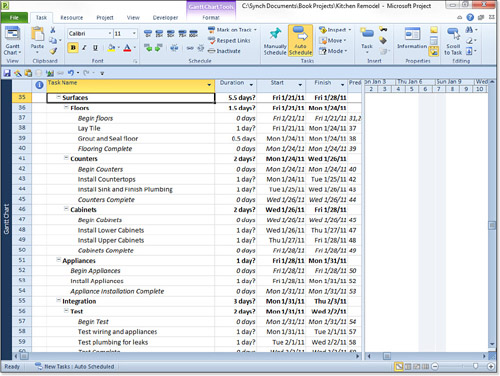WBS and Scheduling
Regardless of the methods that are chosen to create
the schedule, the process will be iterative. Some groups will choose to
begin the process using top-down decomposition. Others may choose to
identify all of the work they can using brain-storming techniques and
then organize the work into logical packages. Either method is
effective as a starting point. Multiple iterations of each method will
be used before the team will be satisfied that all the work has been
identified. It is important to remember that certain types of work,
such as integration of elements, are often only recognized from the
bottom-up view. Examples of this include assembly of components in a
manufacturing project or quality testing in a software project.
The iterative nature of building a WBS, and
subsequently a schedule, requires a great deal of realignment and
reordering of elements. When developing and maintaining the WBS
structure, it is important that you remember the 100% rule mentioned
previously. You should maintain work packages as units and move them as
units within the schedule rather than moving individual tasks below the
work package. After you have identified the work packages, you can
rearrange them, but you should have the same set of lowest-level work
packages regardless of the realignment. Use the 100% rule to validate
the process and always focus on the outputs of the packages rather than
the resources required to do the work.
Tip
Remember that the work package
is the lowest component of a WBS; after you are sure that you have
captured all of them, organize them in a way that is meaningful to the
team. Tasks are defined at the level below the work package. |
Figures 4 and 5
show examples of how work packages can exist in different locations in
the project schedule. In this case, the work package called “Cabinets”
exists under the Level 2 task “Surfaces” in Figure 4, and under the Level 2 task “Storage” in Figure 5.
Remember, a work package is defined as the lowest level of the WBS; the
tasks (activities to be performed) are broken out below the work
package level.


Avoid the tendency to define the work according to
the groups that may be performing the work during initial decomposition
because this will limit your thinking and make it easier to violate the
100% rule. Instead, focus on the work to be delivered and then assign
it to a group as appropriate.
After
the team is satisfied that all work has been captured and decomposed to
the appropriate level, the WBS work packages are set to be the basis
for adding precedence and resources and creating a schedule. The work
packages should have starting and ending milestones to aid with work
flow and to ensure that the focus remains on the production of
deliverables. Refer to Figure 2 for examples of these milestones.
Use of Templates
Most organizations repeatedly deliver
similar projects. Templates can be extremely useful for capturing the
best practices developed into repeatable standards and reporting,
giving new projects a jumpstart to success. The top two levels of the
WBS can often be used consistently across an organization. The project
management elements can be standardized, as can many other
cross-cutting elements. Standard templates will minimize the amount of
startup work required to determine process use for each project and
will also improve the organization’s ability to control scope on the
elements that are consistent across projects.